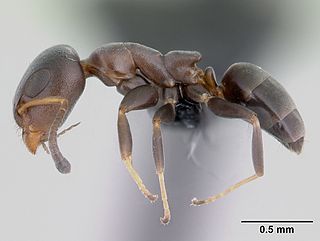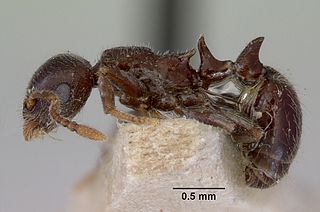
Dolichoderinae is a subfamily of ants, which includes species such as the Argentine ant, the erratic ant, the odorous house ant, and the cone ant. The subfamily presents a great diversity of species throughout the world, distributed in different biogeographic realms, from the Palearctic, Nearctic, Afrotropical region and Malaysia, to the Middle East, Australian, and Neotropical regions.

Turneria is a genus of ants that belongs to the subfamily Dolichoderinae. Known from Australia, they form small colonies of fewer than 500 workers, and nest in trees and twigs.

Iridomyrmex, or the rainbow ant is a genus of ant first described by Austrian entomologist Gustav Mayr in 1862. He placed it in the subfamily Dolichoderinae of the family Formicidae. There are 79 described species and five fossil species. Most of these ants are native to Australia; others are found in Asia and Oceania, and they have been introduced to Brazil, New Zealand and the United Arab Emirates. Fossil species are known from China, France and the United States.
Nurteria is a genus of flies in the family Dolichopodidae, found in the Afrotropical realm. Three species are currently known in the genus, but there are also numerous undescribed species of the genus from southern Africa. It was originally described in the subfamily Diaphorinae, though it possesses some features of the Sympycninae.

Myrmecina is a genus of ants in the subfamily Myrmicinae. It contains 51 species distributed in North America, Europe, northern Africa, India east, Korea, Japan and Australia.

Dolichoderus is a genus of ants found worldwide.

Ochetellus is a genus of ants first described by Steve Shattuck in 1992. He placed it in the subfamily Dolichoderinae of the family Formicidae. The ants in this genus are small and black in colour; workers measure 1.75 to 3 millimetres in length, the males at around 1.6 millimetres (0.06 in) are smaller, and the queens are the largest, reaching 4 millimetres (0.16 in). There are seven described species and three described subspecies that mostly live in Australia in a wide variety of habitats, but some species are found in Asia. One species, Ochetellus glaber, has been introduced into New Zealand and the United States.

Colobostruma is a genus of ants in the subfamily Myrmicinae. All except one species are restricted to Australia. The only non-Australian species, C. foliacea, is found in New Guinea and the Solomon Islands.

Peronomyrmex is a rare genus of ants in the subfamily Myrmicinae. Its three species are known from the east coast of Australia. With only five specimens in total, collected from four localities, Peronomyrmex is one of the world's most rare ant genera.

Nylanderia is a large genus of ants in the subfamily Formicinae. The genus has a nearly cosmopolitan distribution with species inhabiting a wide array of habitats in almost all geographic regions. Nylanderia, currently containing over 110 species, is an ecologically important genus, with some species reported as being invasive. The ants are small to medium in size and range in color from pale yellow to black.

Leptomyrmecini is a tribe of Dolichoderinae ants with 16 genera and two extinct genera.

Mayriella is an Indo-Australian genus of ants in the subfamily Myrmicinae. Colonies in this genus are very small, typically consisting of 50 - 100 individuals.
Turneria arbusta is a species of ant in the genus Turneria. Described by Shattuck in 1990, the species is endemic to Papua New Guinea.

Turneria bidentata is a species of ant in the genus Turneria. Described by Forel in 1895, the species is endemic to Australia, mostly found in the north ends of the country.
Turneria collina is a species of ant in the genus Turneria. Described by Shattuck in 1990, the species is endemic to Papua New Guinea.
Turneria dahlii is a species of ant in the genus Turneria. Described by Forel in 1901, the species is endemic to New Guinea, the Solomon Islands and Vanuatu.
Turneria frenchi is a species of ant in the genus Turneria. Described by Forel in 1911, it is endemic to Australia, but original specimens of the ant have been lost, and its placement in a genus has been in question. The ant has been transferred various times, notably being transferred to Stigmacros in 1990 but then put back into Turneria in 1992.

Turneria pacifica is a species of ant in the genus Turneria. Described by William M. Mann in 1919, the species is endemic to the Solomon Islands and Vanuatu.
Turneria rosschinga is a species of ant in the genus Turneria. Described by Shattuck in 2011, the species is endemic to Australia.










